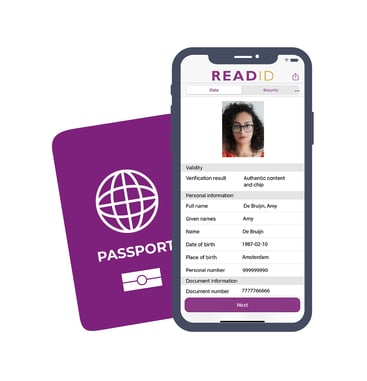Europe is currently buzzing over the upcoming digital identity wallets as part of the amended eIDAS regulation. EU digital identity wallets have the potential to provide a safe, reliable, and private means of digital identification for everyone in Europe. In this blog we explain why any trusted wallet eco-system needs to leverage your chipped identity document: to onboard your identity into the wallet, to recover your wallet if you get a new phone, and to get your face image as an attribute into the wallet.
If the timelines of the eIDAS regulation are followed, European Member States will start to roll-out identity wallets during 2026. A completely new eco-system and governance infrastructure will be created to orchestrate this. This infrastructure includes certified wallets, relying parties, and attribute providers. Member States need to ensure that personal data can be sent to the wallet in a an eIDAS level High compliant way. Identity wallets are likely to be implemented as a mobile application.
This allows the user to identify oneself at the highest assurance level, to manage and share a wide range of digital documents or attribute attestations, and to digitally sign documents. User friendliness, interoperability and security are key aspects that are necessary for the rollout of identity wallets across Europe.
There are three wallet flows where NFC-based identity verification is a quintessential component:
- Onboarding: getting your digital identity (the so-called PID) into the wallet;
- Recovering your wallet without the risk of wallet-takeover;
- Getting your face image as a trusted (qualified) attribute into the wallet.
We’ll discuss them one by one. NFC-based identity verification is vital here because all European governments have already given their citizens a digital identity that everybody carries with them: in your identity document there is a chip with that digital identity. It is decentralised, well-protected from eavesdropping, cannot be tampered with and it cannot be copied without detection. This holds for passports, identity cards as well a residence permits throughout Europe. Your identity document can be seen as an authoritative source for your PID and face image, given to you by your government.
If you are curious about what’s inside the chip, check your document with our personal app, ReadID Me.
In addition, it can be seen as a personalised ‘what-you-have' authentication factor, issued by the government, a trusted source, via a proven and secure process.
Onboarding
NFC-based identity verification should be used for wallet onboarding and binding the wallet to its user at the highest eIDAS assurance level. By utilising decentralised identity documents, privacy by design is considered, i.e. the use of a central identity register is not needed. This aligns with the guiding principles for wallets.
Furthermore, identity documents are standardised at a global level by the International Civil Aviation Organisation, a body of the United Nations and are proven trustworthy, including in their issuance processes. In other words, a wallet implementing NFC-functionality can onboard any EU citizen, or anybody in possession of a chipped identity document for that matter.
Please note that a central government registry with personal data with an API does not suffice: can you ensure that the person getting the data is actually the person themselves? Either that person should log into the government registry at eIDAS level High (effectively requiring an NFC step in an earlier stage) or the binding leveraging NFC with that person should take place in the transaction itself! The only other way to get to an eIDAS High level of assurance would be if every European citizen would go to a government office for in-person identification. This does not scale, with more than 500 million EU citizens. Nor will it work if people must travel far to have it done. It would be a recipe for failure of wallets, hence the need for remote identity verification via NFC chip reading.
Wallet Recovery
In case the user loses their wallet credentials or get a new smartphone and need to reinstall the EU digital identity wallet, re-identification or re-binding can be easily catered for via NFC-reading of an identity document in combination with holder verification. This provides a direct binding between the user and their identity document (by face verification) and the provided PID (by performing identity attribute matching with NFC-read identity information). An alternative is leveraging a government eID High solution, but not all European member states have a notified eID High solution, or these have a limited coverage of the population. Other possible solutions, such as physical registration at the municipality, do not work for the same reasons provided above.
A Face You Can Trust
Chipped identity documents are uniquely positioned to create a trusted face attribute attestation that can be uploaded to and shared by the wallet. This face image is needed for usage of the wallet for face-to-face use cases, for example, for proof of age when purchasing alcohol in a bar. The face image can read from the chip of an identity document in full colour, high resolution, without watermarks. Other relevant attributes can be a demonstration of proof of life, or a Digital Travel Credential attestation created from an NFC-read passport that allows one to conveniently travel across Europe.
Most European Member States do not have central registries of face images. This makes your identity document the only universal trusted source for this attribute.
Summarising
Europe has set itself a major challenge with the rollout of interoperable digital identity wallets for all its citizens and that should be accepted by public and private services. As an EU Member State, you need to get the digital identity in the user's wallet in the most secure way. This can be done in a face-to-face process or remotely with NFC. The PID can be easily generated from the data read from chip and provisioned as a verifiable credential conform the eIDAS ARF. The identity documents you have provided to your citizens are a decentralised, privacy-by-design based route to getting PID into the wallet.
For wallet providers or integrators, the wallets you have and work with are as useful as the data they can help to share. ReadID can help create attestations at the highest trust level. An attestation that contains the face image read from the chip of an identity document, that demonstrates a proof of life, a proof of binding between the user and their wallet and associated attestations, or a Digital Travel Credential created from an NFC-read passport. And wallet recovery will be easy and trusted, without the need for expensive contact centres.
NFC-based identity verification is a proven technology. European governments, banks worldwide and eIDAS High Trust Service Providers use it. If done properly, it combines trust and a great citizen journey. ReadID has shown that it can do so, with high conversion and zero fraud. Bootstrap the EU wallet eco-system with NFC-based identity verification.










